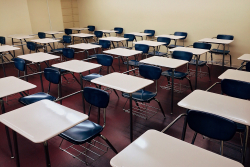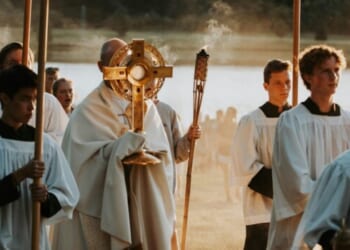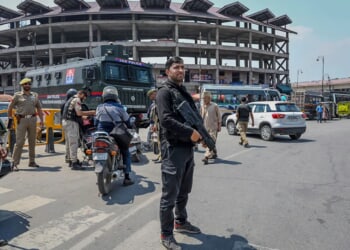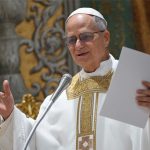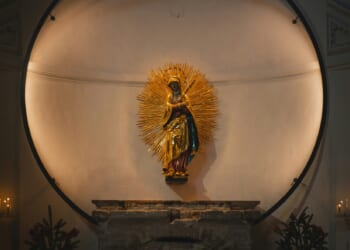A recital by Evgeny Kissin in Carnegie Hall is a regular event—and “event” is the right word. A Kissin recital is an event because of the stage seating (the overflow crowd on the stage). But also because of the personal solemnity and earnestness of the pianist. He is not “one of the guys.” He does not take a mic and say, “Hey, y’all, how you doin’ tonight? Wanna hear some Bach and such?” No. He is a pianist of the old school (complete with concert tails).
Kissin was in Carnegie Hall on Saturday night. He began with Bach: the Partita in C minor. I thought of Wanda Landowska—who said, “You can play Bach your way, I’ll play him his way.” She made this remark in a friendly spirit to Pablo Casals. But it has come down to us as a censorious proclamation.
There is more than one way to skin the cat of Bach. I am happy to listen to Landowska and Casals. And to Samuil Feinberg and Glenn Gould and many others. The chief question, it seems to me, is not musicological but this: Is it musical, the person’s playing?
About Kissin’s playing of the C-minor Partita, I will record a few generalities. It was big and pianistic (not too big). It was measured, steady. Kissin maintains a good pulse. I would have liked more lyricism, more seamlessness. At times, I could hear the hammers move up and down. But everything was in balance. Each note or phrase fit the whole. Kissin is a pianist of integrity (whether we are agreeing with him, interpretively, or not).
After Bach came Chopin—two nocturnes and a scherzo. The first nocturne was that in C-sharp minor, Op. 27, No. 1. This is one of the most magical pieces the composer ever wrote (which is saying something).
Before beginning the melody in the right hand, Kissin hesitated—a choice (though maybe not yours or mine). Some of the notes, he jabbed. Thumped. This did not serve the melodic line well. Yet the octaves at the end of the middle section? They were huge, rich, resonant—perfect.
The second nocturne was Op. 32, No. 2, which is in A flat. From Kissin’s hands, it was certainly adequate. And the scherzo was No. 4 in E—maybe the least played of the four. It is an inventive, mercurial, meandering thing, almost Lisztian. But it is not without structure. And Kissin honored its structure.
An aside: We are not prone to thinking of Chopin and Liszt as contemporaries—because the latter lived so much longer than the former. But they were born a year apart: Chopin in 1810, Liszt in 1811.
From Kissin, the Scherzo’s Trio was unusually plaintive—and very effective. Also, Kissin did some incredibly limpid playing in this work. If he plays un-limpidly, it’s because he wants to—not because he is incapable of this creamy, sparkling, horizontal stuff.
After intermission, Kissin turned to Shostakovich. He started with the Sonata No. 2 in B minor, Op. 61, which is not very often heard. Gabriela Montero played it in Carnegie Hall three seasons ago. Gilels played it at Carnegie in 1964. The sonata has been heard in the hall only seven times.
It has the air of a “private piece,” I think (and it is certainly not a showpiece). Shostakovich wrote it after the death of his beloved teacher, Leonid Nikolayev.
Evgeny Kissin played the sonata with great intensity. I had better explain what I mean. I am not saying that he was fast, loud, or fierce. I am not talking about the physical, really. I’m talking about an intensity of mind—an extraordinary concentration and an underlying emotion. The music was speaking to Kissin, and he, in turn, was speaking it to us, the audience.
He is a stupendous virtuoso, but some of his most impressive playing in this sonata was of simple single notes—intoned with something like love, I want to say.
All in all, Kissin’s traversal of the Shostakovich B-minor was one of the outstanding performances in New York in the entire 2024–25 season.
He followed that up with four other Shostakovich pieces, or two pairs: the Prelude and Fugue in D-flat major and the Prelude and Fugue in D minor. He understands this music very well (and of course has the technical means to convey his understanding).
Is he at one with Shostakovich because he was Soviet-born, like Shostakovich? (Actually, the composer was born eleven years before the October Revolution.) I believe the answer is no. He just “gets” Shostakovich, musically.
The D-minor Fugue was almost prayerful. And it ended with some patented Kissin octaves.
From the audience—onstage and out in the seats—there was considerable appreciation, and Kissin sat down for his first encore: the Bach-Kempff Siciliano. Kissin has a longstanding relationship with this piece. (He is now fifty-three.) He has been playing it since he was a boy (watch him here).
They wanted another one, the audience did—and Kissin gave them a long one: an unusually long piece for an encore. He sat down to play probably the most famous Chopin scherzo of all: No. 2 in B-flat minor.
I have been listening to this fellow play since he was twelve (I was twenty). Seldom have I heard him play with such freedom. He was utterly free in the scherzo, the master of his domain (or Chopin’s). This was virtuosity and musicality in the grand style.
Kissin did not request that the house lights be turned up and the audience did not leave. Finally, the pianist offered one more: Chopin’s Waltz in C-sharp minor, which was unusually slow—but not too slow—and delicious.
Not everything Kissin does is a home run, heaven knows. But his batting average is high, and he was Ohtani-like at Carnegie Hall on Saturday night.











